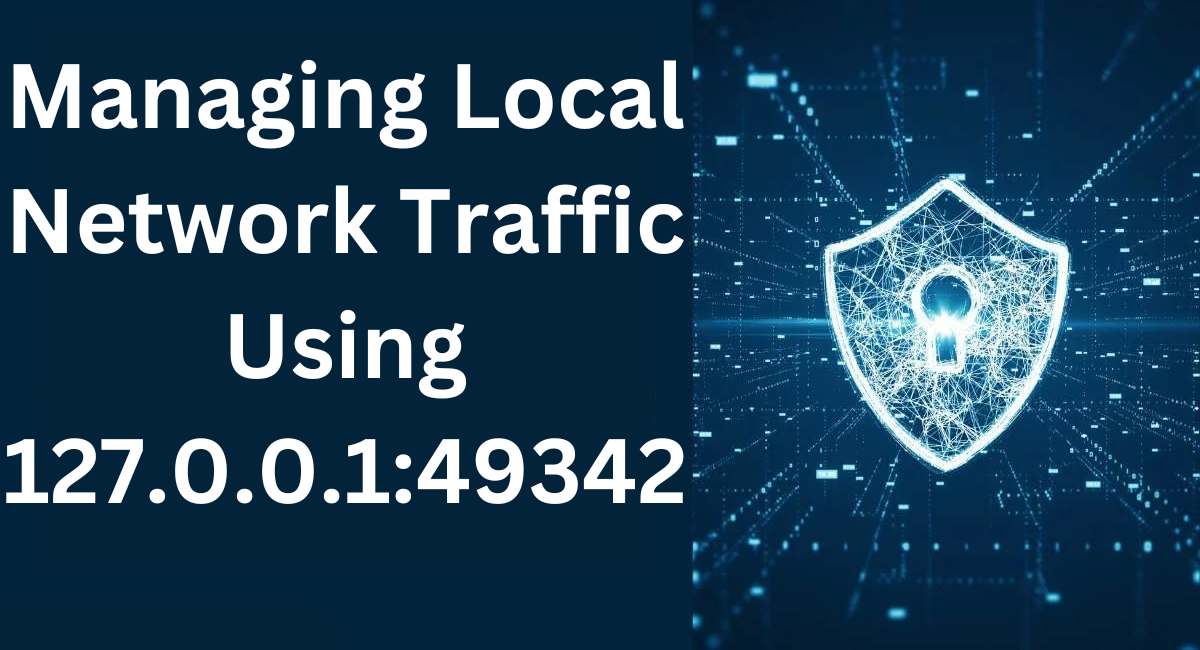In network management and software development, understanding how to manage local network traffic is essential for creating, testing, and debugging applications. The IP address 127.0.0.1, commonly referred to as localhost, is crucial for local network traffic management as it enables communication within the same machine. When paired with a specific port like 49342, it allows developers to run and test network applications in a controlled environment. This article provides a comprehensive guide to managing local network traffic using 127.0.0.1:49342, covering setup, usage, troubleshooting, and advanced configurations.

Understanding Localhost and Port 49342
Localhost (127.0.0.1) is a reserved IP address that refers to the local computer. It is used to establish a loopback connection, allowing applications on the same machine to communicate with each other without external network involvement. Port numbers, such as 49342, identify specific services or applications running on localhost, enabling multiple services to operate simultaneously without interfering with each other.
Setting Up Local Network Traffic Management
To effectively manage local network traffic using 127.0.0.1:49342, follow these steps:
- Assigning Port 49342 to Your Service:
- Configure the application or service to listen on port
49342. This usually involves setting the port number in the application’s configuration files or startup parameters. For example, if you’re running a local web server, you might set it up to bind to127.0.0.1and listen on port49342.
- Configure the application or service to listen on port
- Testing Connectivity:
- After configuring your service, test connectivity by opening a web browser or a network client and navigating to
http://127.0.0.1:49342. If the service is running correctly, you should see the application’s interface or receive a response from the service.
- After configuring your service, test connectivity by opening a web browser or a network client and navigating to
- Monitoring Traffic:
- Use network monitoring tools to track and analyze traffic on port
49342. Tools like Wireshark or NetFlow can help you observe the data being transmitted and identify any anomalies or performance issues.
- Use network monitoring tools to track and analyze traffic on port
- Adjusting Firewall and Security Settings:
- Ensure that your local firewall or security software is configured to allow traffic on port
49342. Although this port is used for local communication, local security software may block it if not properly configured.
- Ensure that your local firewall or security software is configured to allow traffic on port
Common Use Cases
- Web Development:
- During web development, developers use
127.0.0.1:49342to test web applications locally before deployment. By using a specific port, developers can run multiple local servers and services simultaneously without port conflicts.
- During web development, developers use
- Database Testing:
- Port
49342might be used by a database management system for local testing. Configuring the database to use this port allows developers to interact with the database and run queries locally.
- Port
- API Development:
- When developing APIs, using
127.0.0.1:49342allows developers to host and test API endpoints locally. This setup facilitates debugging and testing before making the API available on a public server.
- When developing APIs, using
- Network Security Testing:
- Security professionals use localhost ports for penetration testing and vulnerability assessments. By simulating attacks and testing security measures on
127.0.0.1:49342, they can ensure that local services are secure.
- Security professionals use localhost ports for penetration testing and vulnerability assessments. By simulating attacks and testing security measures on
Also Read : Localhost Communication Using 127.0.0.1:62893 | 10.10.10.2 in Network Security
Troubleshooting Local Network Traffic
- Port Not Listening:
- If you cannot connect to
127.0.0.1:49342, ensure that the application is correctly configured to listen on this port. Use commands likenetstatorssto check if the port is open and listening for connections.
- If you cannot connect to
- Connection Refused:
- A “connection refused” error typically indicates that no service is listening on port
49342. Verify that the service is running and properly configured to use the correct port.
- A “connection refused” error typically indicates that no service is listening on port
- Port Already in Use:
- If port
49342is already in use by another application, you might encounter conflicts. Use network tools to identify the application using the port and either stop it or reconfigure your service to use a different port.
- If port
- Firewall or Security Software Blocking Traffic:
- Ensure that local firewalls or security software are not blocking traffic to port
49342. Adjust firewall rules or security settings as needed to permit local traffic.
- Ensure that local firewalls or security software are not blocking traffic to port
Advanced Configuration and Management
- Using Virtual Hosts:
- Configure virtual hosts to manage multiple local services on different subdomains or paths while using the same IP address and port. For example, you can set up virtual hosts to direct traffic to different applications running on
127.0.0.1:49342.
- Configure virtual hosts to manage multiple local services on different subdomains or paths while using the same IP address and port. For example, you can set up virtual hosts to direct traffic to different applications running on
- Port Forwarding:
- For more advanced setups, use port forwarding to redirect traffic from other ports to
49342. This technique is useful for testing applications that need to simulate traffic from different ports or devices.
- For more advanced setups, use port forwarding to redirect traffic from other ports to
- Load Balancing:
- In a development environment, simulate load balancing by running multiple instances of services on different ports and directing traffic to them. This setup helps test how applications perform under different load conditions.
- Logging and Analysis:
- Implement comprehensive logging to track traffic and diagnose issues. Log files can provide valuable insights into the behavior of services and help in troubleshooting problems with local network traffic.
Security Considerations
- Secure Local Connections:
- Although
127.0.0.1is not exposed to external networks, ensure that local connections are secure. Implement measures such as encryption and authentication for sensitive applications.
- Although
- Regular Updates:
- Keep your applications and services up to date to protect against vulnerabilities. Regular updates help ensure that any security issues related to local network traffic are addressed.
- Access Control:
- Limit access to local services and ports based on need. Ensure that only authorized users can interact with services running on
127.0.0.1:49342.
- Limit access to local services and ports based on need. Ensure that only authorized users can interact with services running on
Conclusion
Managing local network traffic using 127.0.0.1:49342 is a fundamental skill for developers and network administrators. By understanding how to configure, test, and troubleshoot local communication on this address and port, you can effectively manage and optimize your local development and testing environments. This guide provides a comprehensive overview of the setup and management of local network traffic, offering practical insights and advanced techniques to enhance your network and application workflows.
Also Read: 10.0.0.0.1 in Network Configurations | 192.168.0.200 for Router and Device
